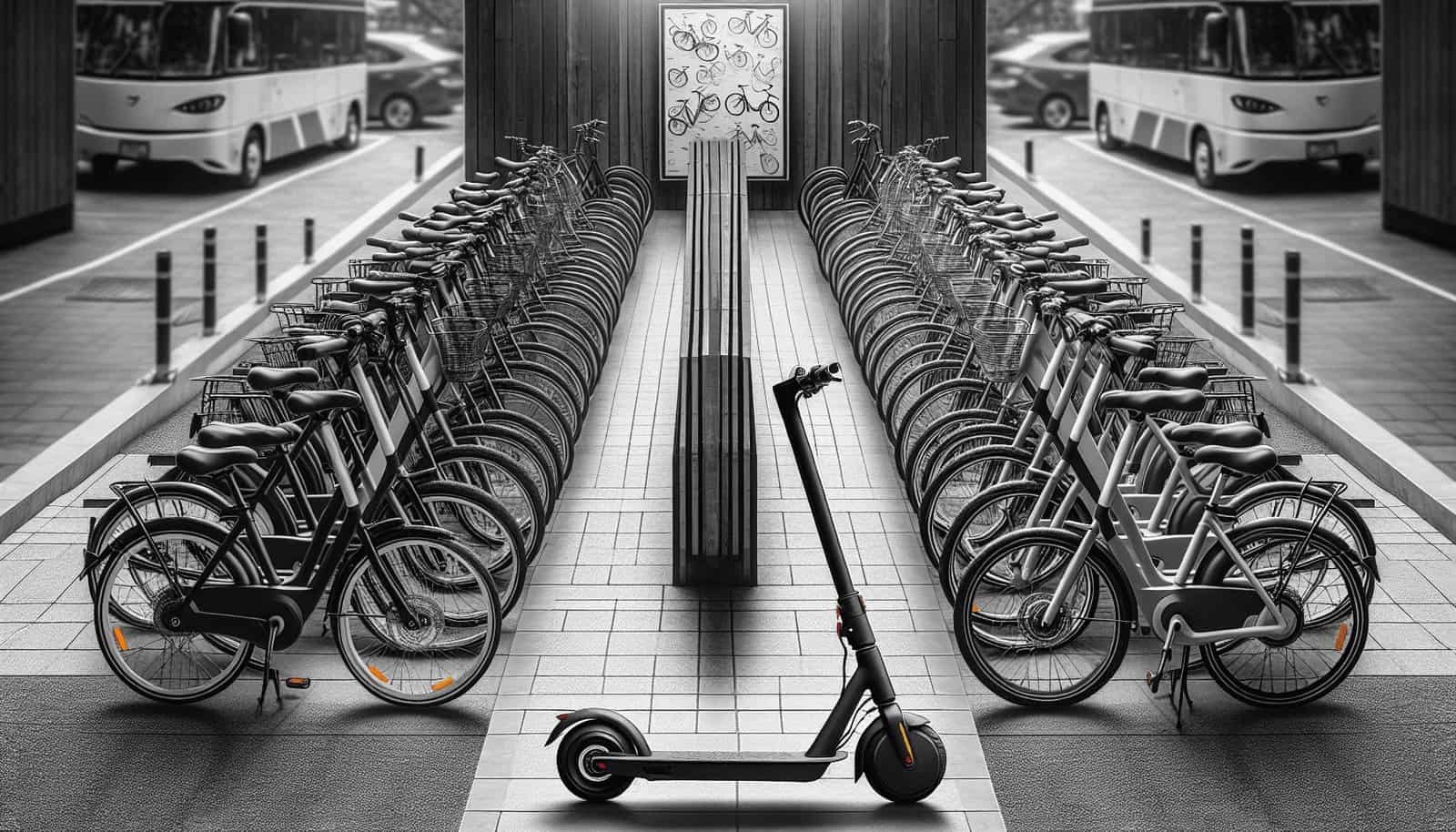Imagine breezing through the city streets on an electric scooter, effortlessly avoiding traffic and exploring the city at your own pace. But wait, can you use an electric scooter in bike-sharing programs? The answer to this question may surprise you. Electric scooters have become increasingly popular as a sustainable mode of transportation, but are they compatible with existing bike-sharing networks? In this article, we will explore the feasibility of incorporating electric scooters into bike-sharing programs, examining the potential benefits and challenges that may arise. So, fasten your helmet and join us as we embark on this electrifying adventure.
Definition of bike-sharing programs
Bike-sharing programs, also known as bicycle-sharing programs, are transportation systems designed to provide individuals with access to bicycles for short-term use. These programs allow users to rent a bicycle from a designated station and return it to another station after their journey is completed. The main goal of these programs is to provide a convenient and sustainable alternative to traditional modes of transportation.
Types of bike-sharing programs
Bike-sharing programs can be categorized into two main types: docked bike-sharing programs and dockless bike-sharing programs.
Docked bike-sharing program
In a docked bike-sharing program, bicycles are parked and locked at designated docking stations throughout the city. Users can easily locate and rent bicycles from these stations by using a membership card or a smartphone app. Once their trip is finished, the bicycles must be returned to an available docking station.
Docked bike-sharing programs offer a well-organized system that ensures bicycles are readily available at designated stations. This type of program provides users with the convenience of knowing where to find a bike when they need one, as well as the certainty that they will have a docking station available at their destination to return the bike to.
Dockless bike-sharing program
Dockless bike-sharing programs operate differently from docked programs as they do not require users to return bicycles to specific docking stations. Instead, bicycles are equipped with GPS technology, allowing users to locate and unlock available bikes through a smartphone app.
Once a user completes their journey, they are able to park the bike and lock it within a specified area, as outlined by the program’s guidelines. Dockless bike-sharing programs give users greater flexibility in terms of picking up and dropping off bicycles, as they are not confined to specific docking stations. However, they also come with their own set of challenges, such as potential issues with bicycle distribution and responsible parking behavior.

Advantages of bike-sharing programs
Bike-sharing programs offer several advantages that contribute to a more sustainable and efficient urban transportation system.
Promotes sustainable transportation
By providing an accessible and affordable transportation option, bike-sharing programs encourage individuals to choose cycling instead of utilizing private vehicles or relying solely on public transportation. This shift helps reduce greenhouse gas emissions, improve air quality, and contribute to a more sustainable environment.
Reduces traffic congestion
Bike-sharing programs can significantly alleviate traffic congestion in busy urban areas. With more people choosing to ride bicycles instead of driving cars, there are fewer vehicles on the road, resulting in reduced traffic congestion and improved traffic flow.
Improves health and fitness
Regular physical activity is crucial for maintaining good health and overall well-being. Bike-sharing programs promote active lifestyles by encouraging individuals to incorporate cycling into their daily routines. By choosing to cycle instead of taking a sedentary mode of transportation, individuals can improve their cardiovascular health, enhance muscle strength, and achieve their fitness goals.
Drawbacks of bike-sharing programs
While bike-sharing programs offer numerous benefits, there are also some drawbacks that need to be taken into consideration.
Limited coverage area
One drawback of bike-sharing programs is that they often have limited coverage areas. As these programs require the availability of docking stations or a specified zone for dockless parking, the service may not be accessible to individuals living in remote or less densely populated areas. This limitation may prevent some people from utilizing the benefits of bike-sharing programs and limit the overall reach and impact of these initiatives.
Limited availability of bikes
Another common issue with bike-sharing programs is the limited availability of bikes, especially during peak hours or in popular locations. Users may encounter situations where all nearby bikes are already in use or all docking stations are full. This can be frustrating and inconvenient, as it may require individuals to look for alternative modes of transportation or wait for a bike to become available.
Potential maintenance issues
In bike-sharing programs, bicycles undergo constant use and are exposed to various weather conditions and daily wear and tear. This can result in regular maintenance issues, such as flat tires or faulty brakes. Ensuring the smooth operation and maintenance of bicycles is crucial to avoid service disruptions and ensure user satisfaction. Bike-sharing programs require maintenance teams to address these issues promptly and efficiently to maintain a reliable service for users.

Introduction to electric scooters
Electric scooters, also known as e-scooters, have gained significant popularity as a convenient and eco-friendly mode of transportation in recent years. These electric-powered two-wheelers provide a cost-effective and efficient way to travel short distances, making them an ideal option for urban mobility.
Electric scooters in bike-sharing programs
Bike-sharing programs have started to explore the inclusion of electric scooters as an addition to their existing fleets of bicycles. The integration of electric scooters in these programs offers numerous benefits and addresses some of the challenges faced by traditional bike-sharing programs.
Compatibility with existing infrastructure
Electric scooters can leverage the existing infrastructure of bike-sharing programs, such as docking stations or designated parking zones. As they are similar in size and form to bicycles, electric scooters can seamlessly fit into the current infrastructure, making it easier for bike-sharing programs to incorporate them into their operations.
Integration of electric scooters into bike-sharing programs
By incorporating electric scooters, bike-sharing programs can cater to a wider range of users who may prefer the convenience and speed that electric scooters offer. This integration allows users to choose between bicycles and electric scooters based on their personal preferences, distance, and terrain.
Advantages of using electric scooters in bike-sharing programs
Utilizing electric scooters in bike-sharing programs provides several advantages over traditional bicycles.
Increased range and speed
Electric scooters offer increased range and speed compared to traditional bicycles. With their electric motors, scooters can cover longer distances in less time, allowing users to reach their destinations more quickly and efficiently. This extended range makes electric scooters particularly suitable for commuting or traveling across larger urban areas.
Easier to navigate through traffic
Due to their compact design and electric motor, electric scooters are easier to maneuver through traffic than bicycles. They can quickly navigate congested areas, narrow streets, and busy intersections, making them an ideal mode of transportation for urban environments.
Less physical exertion
Using an electric scooter requires less physical exertion than riding a bicycle. This can be beneficial for individuals who may have limited physical stamina or prefer a less strenuous mode of transportation. Electric scooters allow riders to enjoy the benefits of cycling without the physical effort required.
Challenges of using electric scooters in bike-sharing programs
While electric scooters offer numerous advantages, their integration into bike-sharing programs also presents some challenges that need to be addressed.
Battery life and charging infrastructure
Electric scooters rely on battery power, and their usability is limited by battery life. Sufficient charging infrastructure is crucial to ensure a continuous supply of fully charged scooters for users. Bike-sharing programs must establish an effective charging network to regularly recharge scooters and redistribute them throughout the service area.
Safety concerns
As electric scooters become more prevalent, safety concerns have arisen. Users must be educated about proper scooter usage and safety precautions to mitigate the risk of accidents. Bike-sharing programs must collaborate with local authorities to implement regulations, enforce helmet use, and promote responsible riding behaviors to ensure the safety of both riders and pedestrians.
User education and training
Educating users about electric scooter usage and providing training on safe riding practices are essential to prevent accidents and minimize risks. Bike-sharing programs should offer comprehensive guidelines, online resources, and potentially even training sessions to familiarize users with electric scooters and promote responsible riding habits.

Potential solutions and adaptations for electric scooters in bike-sharing programs
To address challenges associated with electric scooters in bike-sharing programs, certain solutions and adaptations can be implemented.
Expansion of charging infrastructure
To ensure a consistent supply of fully charged scooters, bike-sharing programs can expand their charging infrastructure by installing more charging stations throughout the service area. This would allow scooters to be charged and made available to users more efficiently, minimizing any inconvenience due to low battery levels.
Enforcement of safety regulations
Collaboration with local authorities is essential to enforce safety regulations for electric scooter riders. This can include implementing speed limits, promoting helmet usage, and enforcing penalties for reckless riding. By actively enforcing safety regulations, bike-sharing programs can ensure the well-being of riders, pedestrians, and the overall community.
Integration of scooter-specific features in bike-sharing apps
To enhance user experience, bike-sharing programs can develop or update their smartphone apps to include features specific to electric scooters. These features may include real-time battery level information, scooter availability alerts, and suggested scooter routes. This integration can provide users with valuable information to make informed decisions and optimize their scooter-sharing experience.
Conclusion
Bike-sharing programs have revolutionized urban transportation by offering a sustainable and convenient alternative to traditional modes of commuting. The integration of electric scooters into these programs further expands the range of options available to users, providing increased speed, reduced physical exertion, and enhanced flexibility. While challenges such as limited coverage, maintenance, battery life, and safety concerns exist, these can be overcome through infrastructure improvements, user education, and ongoing collaboration with local authorities. With careful planning and adaptation, bike-sharing programs can continue to evolve and meet the diverse needs of urban dwellers while promoting sustainable and efficient transportation options.



